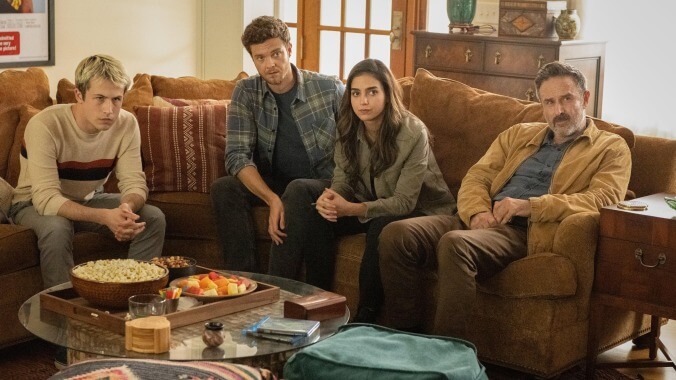A new generation takes a stab at Scream in the first sequel without Wes Craven
Neve Campbell, Courteney Cox, and David Arquette star alongside a young cast of hyper-articulate cannon fodder

Cell phones were supposed to kill off the slasher picture. For a genre built on isolation, miscommunication, and unheard cries for help, surely the ability to contact anyone, anywhere with the push of a button would be (pardon the pun) a death blow? And it might have been, if those masked killers—and the people who bring them to life—weren’t so darn resilient. Scream, the fifth film in the postmodern slasher series that confusingly shares a title with the first, engages with this conundrum throughout. In the 2022 Scream, smart home devices, location tracking apps, and phone cloning software are all tools in the Ghostface Killer’s murder kit.
But Ghostface has always been savvy. The killer(s) kind of have to be, given the hyper-articulate, horror-obsessed nature of their prey. And the Gen Zers in this installment are just as well-spoken as their ‘90s counterparts: In an opening riff on a classic sequence where Drew Barrymore is terrorized by phone in the 1996 original, snarky teenager Tara (Jenna Ortega) tells the modulated voice on the other end of her family’s land line that she’s into “elevated horror,” name dropping A24's greatest hits while condescendingly explaining that those films are more than cheap thrills. They’re metaphors.
The script, from veteran screenwriter James Vanderbilt and Castle Rock scribe Guy Busick, leans in to the franchise’s fidgety intelligence, swerving and ducking and winking at the camera like the “meta whodunit slasher” it proudly proclaims itself to be. In a signature Scream moment, at one point a character breathlessly monologues on the concept of the “requel,” a reboot-sequel that tries to take a franchise back to its roots through combining “legacy characters”—i.e. Sidney (Neve Campbell), Gale (Courteney Cox), and Dewey (David Arquette), all back for a fifth go-around—with new ones whose family trees contain the secret to the killer’s motive. The cherry on this blood-soaked sundae? The girl doing the monologuing is the niece of Randy Meeks, the original Scream “video store guy.”
With the snake busy eating its own tail in the dialogue, directors Matt Bettinelli-Olpin and Tyler Gillett—last seen pouring buckets of blood on Samara Weaving in the eat-the-rich horror farce Ready Or Not—wisely opt for a flat, bright look that doesn’t distract too much from the script. (Heavy visual stylization on top of the rat-a-tat script would have rendered this film unwatchable.) The movie takes its time ramping up the gore. But as the action escalates, the corn syrup begins to flow more liberally, and the camera lingers a little longer on professionally rendered prosthetics of, say, a teen being stabbed through the neck. But the 2022 Scream—like the 1996 Scream—was made with an eye for cruel economy and merciless suspense, qualities that can make a scene bloodier in memory than it actually appears on screen.
The efficient direction leaves room for the audience to build affection for the characters—or, at least, be able to tell them all apart by the end of the movie. Among the film’s young ensemble cast, Mikey Madison (who viewers might recognize from her role as Manson acolyte “Sadie” in Once Upon A Time…In Hollywood) stands out as ranting paranoiac Amber, as does Jasmin Savoy Brown as Mindy Meeks-Martin, Randy’s aforementioned niece. Ortega and her onscreen sister, Sam (Melissa Barrera), make worthy additions to the horror-heroine canon as well. Ortega’s performance in particular shows incredible toughness and grit, as she runs, crawls, slips on her own blood, and generally fights like hell against Ghostface’s ongoing assault on her family.
Unlike another recent decade-late meta-sequel, The Matrix Resurrections, Scream seems overjoyed to be playing in an established IP sandbox. But the weight of legacy still holds the movie down. (It’s a heavy burden, too. The late Wes Craven, an undisputed horror icon, directed every Scream movie except for this one.) In its strained effort to combine established players with new ones, Scream’s structure nearly collapses on itself, building momentum and then squandering it for a visit with another old pal. This is most obvious with a pivot midway through the film that brings all of the many characters to the same familiar location. It’s a device that lands with a loud, clanging thud.
Essentially coaching from the sidelines, Campbell and Cox are game, if not fully convinced that they should be back in Woodsboro in the first place. (Campbell’s best moment comes early on, when she tells a concerned Arquette, “I’m Sidney fucking Prescott. Of course I have a gun.”) Arquette, meanwhile, treats the saga of Dwight “Dewey” Riley, now a washed-up drunk living in a trailer park, like Shakespearean tragedy. As the reluctant protector/sidekick of the film’s blithe high schoolers, Arquette brings an exhausted resignation to his do-gooder character that’s, if not quite poignant, certainly endearing. It’s an isolated moment of humanity in what’s otherwise a slick, self-satisfied giggle of a movie. But let’s be honest—an overly sentimental take on Scream 5 would have been unbearable.